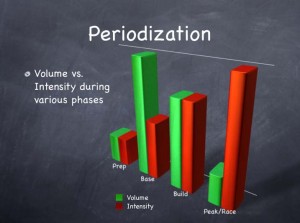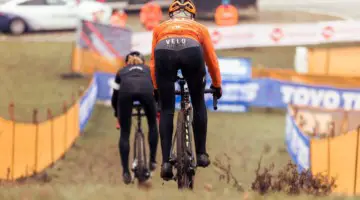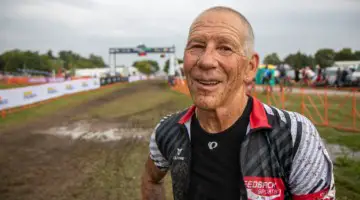June is here in just a week, and September and racing season are not too far behind. If you haven’t started coming up with a plan for the season, now is the time to start, and to help you in this process, we’re highlighting a great past article by USAC Level 2 coach Mike Birner about how to start the season strong by building a good base over the summer. Birner believes that, “Base period should be about building the ‘engine,'” and following his advice will get you one high-horsepower motor!
In this series of four articles, Mike Birner will guide your training through a successful cyclocross season. This is only Part I, originally published in our Issue 3. Stay tuned for reprints of Parts II-IV!
Building a Base: June through September
Since its inception, cyclists have used cyclocross as a means of maintaining their fitness through the off-season until their primary racing season returned. For some that is still the case, but more and more riders each year are deciding to make the cyclocross season their primary focus. If you are reading this magazine or website in the warmer months it’s likely that you are one of those (smart, cool, awesome) people.
So where do you start? If you’ve established that cyclocross is going to be your focus, now is the perfect time to start your planning. Training for any sport can and should be a year-round mindset. This does not necessarily mean you should be training every day of the year; instead it means you should have a plan for what to do year-round. This is critical in allowing you to progress consistently from year to year.
Planning Your Season:
Hopefully, throughout last season you took a mental note as to which races you performed well at and the ones where you didn’t. And perhaps you made a list of what you felt your strengths and weaknesses were, as well. What? You didn’t? Well now is the time. Pull out a pen and paper and write these down now. Were your skills adequate or did you stumble over the barriers repeatedly? Did you have trouble on the long runs? Short runs? Bike handling? Holding a high intensity for the duration of the race? Try to recall some of the events and walk through them in your mind to better understand where you lost time on certain courses. If you are having a hard time remembering, ask some of your fellow race buddies. They’ll usually be able to tell you some strengths and weaknesses and just might give you a whole new perspective on what you originally thought.
For now we’re going to dwell on the negative points-your weaknesses. Circle those weaknesses and formulate goals to overcome them. If barriers were difficult for you, address these skills in your training plan. If recovery between races was the problem, perhaps you didn’t have the aerobic base necessary. Try to break down each of the problems and determine the proper time and method to eliminate them.
Next you will want to plan your season using principles of periodization-the ebb and flow of the training program. Diagram 1 shows a traditional periodization model from preparation periods, through base, build and peak periods, taking you all the way through to your key race period.
What do each of these periods mean regarding specific workouts? In general, each of these allow for a progressive overload in volume, intensity or sometimes both. To be more specific, beginning with the Base period, aerobic training is the main focus. While there are still proponents of the LSD (long, slow distance) approach to base training, it has been shown that higher-level aerobic training can be much more beneficial during this phase and is much more appropriate to training for cyclocross. These types of workouts would include some low intensity mileage, but mostly increasing levels of tempo and threshold work which equate to a moderate to medium-hard intensity for longer periods of time. Some maximal aerobic training (VO2max) can also be brought in during the latter part of this Base phase. This is the key “engine-building” period and will build the platform for harder workouts to come. Also, include some light running so that your cycling muscles will adapt to stresses off the bike. The Build phase brings in all levels of aerobic training and introduces anaerobic training-the shorter, harder efforts anywhere from five seconds up to three minutes. This period is the most difficult, and cyclists must include periodic rest days and weeks to make sure overtraining doesn’t become an issue. Finally, the Peak phase is where your fitness reaches its razor sharp edge. Rest and focus on short, high intensity workouts to allow your body to rebuild and be ready for the main event.
In order to create a periodized plan, you need to determine which races or series of races will be your focus. Your goal may be to stay fit for a longer local series, or you may wish to peak for the local or national championships. Either of these goals would have its own distinct periodization plan, and the sooner you can develop it, the more successful you’ll be for those key races. Below would be a rough model for a mid-December peak towards a local championship.
| Period | Time frame | Dates |
| Base | 16 weeks | June 9th-September 28th |
| Build | 8 weeks | September 29th-November 23rd |
| Peak | 2 weeks | November 24th-December 12th |
| Race | 1 week | December 13th |
The Base Period:
So you’ve done some planning, and you’re now ready to get on the bike. So what are you going to do over the next few months? Like I mentioned above, the Base period should be about building the “engine.” It’s the time to progressively adapt your body to increasing loads of aerobic training. For cyclocross, mileage and time on the bike are obviously not real concerns, so really long rides are not a necessity. So the focus, then, is to overload the body with increasing amounts of tempo (zone 3 heart rate), sweet spot training (SST) (high zone 3, low zone 4), and threshold (zone 4). The table below might be a typical 3-week Base cycle with the 4th week as a rest and active recovery week.
The length and total duration of the intervals, as well as time on the bike, can be increased week to week and month to month throughout the Base phase to continually create a physical overload which your body-through proper recovery-must adapt to.
Keep in mind that this is just a general outline that you can easily adapt around your schedule and current fitness level. Also, depending on your ability, you may need more or less training and interval time as dictated by the level of races that you do. While the plan above recommends approximately eight hours a week, many of you might not have that much time to commit. If that is the case, then always rely on quality over quantity. Aim for the three key interval days as your minimum. If those rides need to be cut short, then get a quick warm-up, head straight into the intervals, and follow up with a short cool-down with only the necessary recovery in between. With a tight schedule, you may also need to find a way to incorporate your skills work into the workouts.
To keep the routine from…well…feeling like a routine, perform the workouts in different ways. Most extended intervals like these are usually best done on open stretches of road with little traffic because the objective is to keep an uninterrupted pace. Of course, there is always the indoor trainer, but who really wants to be subjected to that during the nice summer weather? You can adapt some of your usual routes to fit your needs. Perhaps you have some extended climbs nearby or fire roads with long gradual grades where you can use the mountain or ‘cross bike. If you are in the Midwest, there’s always a trusty headwind to provide some nice resistance. Another excellent method is to simulate your own ‘cross course in a large open field or park (while being careful not to go too hard on certain areas), blending in the necessary skills work as well. You may also wish to find a training partner to make sure you stay honest in your training. Keeping the workouts fresh and enjoyable will ensure you return to do them the following week as well.
Base Period Training Plan
| Monday | Tuesday | Wednesday | Thursday | Friday | Saturday | Sunday |
| Rest or active recovery | 1 hour: 3×10 minute MSS/Threshold intervals |
1 hour 30 min: 2×20 minute tempo intervals Light running |
Rest or active recovery | Skills work, barriers, etc. | 2 hours: 2×20 minute SST intervals |
2 hours: Zone 1/2 endurance ride-also a good day to take the ‘cross bike on the trails. Light running |
| Rest or active recovery | 1 hour: 4×10 minute MSS/Threshold intervals |
1 hour 30 min: 2×30 minute tempo intervals Light/mod running |
Rest or active recovery | Skills work, barriers, etc. | 2 hours: 2×30 minute SST intervals |
2.5 hours: Zone 1/2 endurance ride-also a good day to take the ‘cross bike on the trails. Light/mod running |
| Rest or active recovery | 1 hour: 3×15 minute MSS/Threshold intervals |
1 hour 30 min: 2×40 minute tempo intervals Moderate running |
Rest or active recovery | Skills work, barriers, etc. | 2 hours: 2×40 minute SST intervals |
3 hours: Zone 1/2 endurance ride-also a good day to take the ‘cross bike on the trails. Moderate running |
In the next edition, I will discuss transitioning into the Build phases and managing the rest and recovery with harder efforts.
Managing the Split Season:
Many of you may not be starting from scratch in June. You may already be training and racing a complete road or mountain bike season before you even enter the cyclocross season. This, in some ways, can make things easier and, in other ways, can make things a bit more difficult. What you need to realize is that at some point between the two racing seasons, you’ll need a period of rest, most likely in July or early August. Every year you’ll notice the same trend regardless of your location. The September and early October cyclocross races are loaded with very strong riders carrying their fitness through from the spring and summer races, but by mid-October, they all start to fade away very quickly. It can be very difficult, if not impossible, to race continuously from spring through late fall, and even if you could, your performance would suffer. By creating a proper rest period of 1-2 weeks and then restructuring your training, you are able to rebuild your strength from the peak of your previous racing, creating a stair-step effect in your fitness. By managing the seasons this way, you’ll hit higher levels of performance than you’ve ever reached.
Of course, this means adapting the periodization plan above. You may only have the time to fit in the minimum number of weeks for each phase, but because you are already starting from a decent level of fitness, this will not be a problem. So in this case, your general time line would look like this:
| Period | Time frame | Dates |
| Base | 11 weeks | July 28th-October 12th |
| Build | 7 weeks | October 13th-November 30th |
| Peak | 1.5 weeks | December 1st-December 12th |
| Race | 1 week | December 13th |
For now, I’ve prepared you for a jump-start to your cyclocross season. Next time, I will talk about workouts for the Build period, bringing in increased intensity with your running, and additional ways to incorporate skills work into your training routine.
Glossary
| Workout Terminologies | Length | Intensity | Heart Rate Zone |
| Endurance | Hours | Easy/mod. | Zone 1/2 |
| Tempo | 30-120 min each | Moderate | Zone 3 |
| Sweet Spot Training (SST) | 15-50 min each | Mod/hard | Zone 3/4 |
| Maximum Steady State (MSS) / Threshold | 10-30 min each | Hard | Zone 4 |
| Vo2max | 3-8 min each | Very hard | Zone 5a |
| Anaerobic | Up to 3 min | All out | Zone 5b/c |
Mike Birner is a USAC Level 2 coach and avid cyclocrosser. He coaches all types of cyclists through Mid-Maryland Coaching (www.midmarylandcoaching.com). Want more training-related articles? Hit up our “training” category on our site: https://cxmagazine.com/category/training.





























